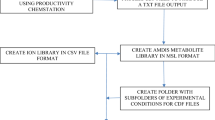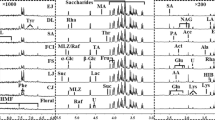Abstract
NMR can be used in food analysis for origin discrimination and biomarker discovery using a metabolomic approach. Here, we present an example of this strategy to discriminate honey samples of different botanical origins. The NMR spectra of 353 chloroform extracts of selected honey samples were analyzed to detect possible markers of their floral origin. Six monofloral Italian honey types (acacia, linden, orange, eucalyptus, chestnut, and honeydew) were analyzed together with polyfloral samples. Specific markers were identified for each monofloral origin: two markers for acacia (chrysin and pinocembrin), one for chestnut (γ-LACT-3-PKA), two for orange (8-hydroxylinalool and caffeine), one for eucalyptus (dehydrovomifoliol), one for honeydew (a diacylglycerilether) and two for linden (4-(1-hydroxy-1-methylethyl)cyclohexa-1,3-diene-carboxylic acid and 4-(1-methylethenyl)cyclohexa-1,3-diene-carboxylic acid). An NMR-based metabolomic approach that used O2PLS-DA multivariate data analysis allowed us to discriminate the different types of honey. Two different classifiers were built based on different multivariate techniques. The high precision of the classification obtained suggests that this approach could be useful to develop generally applicable metabolomic tools to discriminate the origin of honey samples.




Similar content being viewed by others
References
Alissandrakis, E., Tarantilis, P., Pappas, C., Harizanis, P. C., & Polossiou, M. (2011). Investigation of organic extractives from unifloral chestnut (Castanea sativa L.) and eucalyptus (Eucalyptus Globulus Labill.) honeys and flowers to identification of botanical marker compounds. Food Science and Technology, 44, 1042–1051.
Alvarez-Suarez, J. M., Tulipani, S., Díaz, D., Estevez, Y., Romandini, S., Giampieri, F., et al. (2010). Antioxidant and antimicrobial capacity of several monofloral Cuban honeys and their correlation with color, polyphenol content and other chemical compounds. Food and Chemical Toxicology, 48, 2490–2499.
Beretta, G., Artali, R., Caneva, E., Orlandini, S., Centini, M., & Maffei Facino, R. (2009a). Quinoline alkaloids in honey: Further analytical (HPLC-DAD-ESI-MS, multidimensional diffusion-ordered NMR spectroscopy), theoretical and chemometric studies. Journal of Pharmaceutical and Biomedical Analysis, 50, 432–439.
Beretta, G., Vistoli, G., Caneva, E., Anselmi, C., & Maffei Facino, R. (2009b). Structure elucidation and NMR assignments of two new pyrrolidinyl quinoline alkaloids from chestnut honey. Magnetic Resonance in Chemistry, 47, 456–459.
Bertelli, D., Plessi, M., Sabatini, A. G., Lolli, M., & Grillenzoni, F. (2007). Classification of Italian honeys by mid-infrared diffuse reflectance spectroscopy (DRIFTS). Food Chemistry, 101, 1565–1570.
Bertoncelj, J., Polak, T., Kropf, U., Korošec, M., & Golob, T. (2011). LC-DAD-ESI/MS analysis of flavonoids and abscisic acid with chemometric approach for the classification of Slovenian honey. Food Chemistry, 127, 296–302.
Bonaga, G., Giumanini, A. G., & Gliozzi, G. (1986). Chemical composition of chesnut honey: Analysis of the hydrocarbon fraction. Journal of Agriculture and Food Chemistry, 34, 319–326.
Castro-Vázquez, L., Díaz-Maroto, M. C., & Pérez-Coello, M. S. (2007). Aroma composition and new chemical markers of Spanish citrus honeys. Food Chemistry, 103, 601–606.
Codex Alimentarius Commission. (2001). Revised codex standard for honey. Codex Standard 12-1981. Rev.1, 1987. Rev.2, 2001.
EL-Manzalawy, Y., Honavar, V. (2005). WLSVM: Integrating LibSVM into Weka environment. http://www.cs.iastate.edu/~yasser/wlsvm.
Eriksson, L., Johansson, E., Kettaneh-Wold, N., Trygg, J., Wikström, C., & Wold, S. (2006). Multi- and megavariate data analysis. Basic principles and applications. Appendix II. Umeå: Umetrics AB.
Escriche, I., Kadar, M., Juan-Borrás, M., & Domenech, E. (2011). Using flavonoids, phenolic compounds and headspace volatile profile for botanical authentication of lemon and orange honeys. Food Research International, 44, 1504–1513.
Etzold, E., & Lichtenberg-Kraag, B. (2008). Determination of the botanical origin of honey by Fourier-transformed infrared spectroscopy: An approach for routine analysis. European Food Research and Technology, 227, 586–597.
European Commission. (2002). Council directive 2001/110/EC of 20 December 2001 relating to honey. Official Journal of the European Communities, L10, 47–52.
Frérot, E., Velluz, A., Decorzant, E., & Naef, R. (2006). From linden flower to linden honey. Glycosidic precursors of cyclohexa-1,3-diene-1-carboxylic acids. Chemistry & Biodiversity, 3, 94–100.
Graddon, A. D., Morrison, J. D., & Smith, J. F. (1979). Volatile constituents of some unifloral Australian honeys. Journal of Agriculture and Food Chemistry, 27, 832–837.
Guyot, C., Scheirman, V., & Collin, S. (1999). Floral origin markers of heather honeys: Calluna vulgaris and Erica arborea. Food Chemistry, 64, 3–11.
Hennessy, S., Downey, G., & O’Donnell, C. P. (2010). Attempted confirmation of the provenance of Corsican PDO honey using FT-IR spectroscopy and multivariate data analysis. Journal of Agricultural and Food Chemistry, 58, 9401–9406.
Isidorov, V. A., Czyżewska, U., Jankowska, E., & Bakier, S. (2011). Determination of royal jelly acids in honey. Food Chemistry, 124, 387–391.
Ivanciuc, O. (2007). Applications of support vector machines in chemistry. Reviews in Computational Chemistry, 23, 291–400.
Kaškonienė, V., & Venskutonis, P. R. (2010). Floral markers in honey of various botanical and geographic origins: a review. Comprehensive Reviews in Food Science and Food Safety, 9, 620–634.
Liu, R., Gao, M., Yang, Z., & Du, G. (2008). Pinocembrin protects rat brain against oxidation and apoptosis induced by ischemia–reperfusion both in vivo and in vitro. Brain Research, 1216, 104–115.
Marghitas, L. A., Dezmirean, D. S., Pocol, C. B., Ilea, M., Bobis, O., & Gergen, I. (2010). The development of a biochemical profile of acacia honey by identifying biochemical determinants of its quality. Notulae Botanicae Horti Agrobotanici Cluj, 38, 84–90.
Melliou, E., Chinou, I. (2011, in press). Chemical constituents of selected unifloral Greek bee-honeys with antimicrobial activity. Food Chemistry, doi:10.1016/j.foodchem.2011.04.047.
Modi, A. A., Feld, J. J., Park, Y., Kleiner, D. E., Everhart, J. E., Liang, T. J., et al. (2010). Increased caffeine consumption is associated with reduced hepatic fibrosis. Hepatology, 51, 201–209.
Olsson, I.-M., Gottfries, J., & Wold, S. (2004). D-optimal onion designs in statistical molecular design. Chemometrics Intelligent Laboratory Systems, 73, 37–46.
Paris, D., Melck, D., Stocchero, M., D’Apolito, O., Calemma, R., Castello, G., et al. (2010). Monitoring liver alterations during hepatic tumorigenesis by NMR profiling and pattern recognition. Metabolomics, 6, 405–416.
Persano Oddo, L., & Piro, R. (2004). Main European unifloral honeys: Descriptive sheets. Apidologie, 35, S38–S81.
Pichichero, E., Cicconi, R., Mattei, M., Gallinella Muzi, M., & Canini, A. (2010). Acacia honey and chrysin reduce proliferation of melanoma cells through alterations in cell cycle progression. International Journal of Oncology, 37, 973–981.
Plutowska, B., Chmiel, T., Dymerski, T., & Wardencki, W. (2011). A headspace solid-phase microextraction method development and its application in the determination of volatiles in honeys by gas chromatography. Food Chemistry, 126, 1288–1298.
Rastrelli, F., Schievano, E., Bagno, A., & Mammi, S. (2009). NMR quantification of trace components in complex matrices by band-selective excitation with adiabatic pulses. Magnetic Resonance in Chemistry, 47, 868–872.
Ruoff, K., Luginbühl, W., Künzli, R., Bogdanov, S., Bosset, J. O., Von der Ohe, K., et al. (2006). Authentication of the botanical and geographical origin of honey by front-face fluorescence spectroscopy. J. Agr. Food Chem., 54, 6858–6866.
Schievano, E., Peggion, E., & Mammi, S. (2010). 1H nuclear magnetic resonance spectra of chloroform extracts of honey for chemometric determination of its botanical origin. Journal of Agricultural and Food Chemistry, 58, 57–65.
Socha, R., Juszczak, L., Pietrzyk, S., Gałkowska, D., Fortuna, T., & Witczak, T. (2011). Phenolic profile and antioxidant properties of Polish honeys. International Journal of Food Science & Technology, 46, 528–534.
Stephens, J. M., Schlothauer, R. C., Morris, B. D., Yang, D., Fearnley, L., Greenwood, D. R., et al. (2010). Phenolic compounds and methylglyoxal in some New Zealand manuka and kanuka honeys. Food Chemistry, 120, 78–86.
Tan, S.-T., Holland, P. T., Wilkins, A. L., & Molan, P. C. (1988). Extractives from New Zeland honeys. 1. White clover, Manuka and Kanuka unifloral honeys. Journal of Agriculture and Food Chemistry, 36, 453–460.
Truchado, P., Ferreres, F., & Tomas-Barberan, F. A. (2009a). Liquid chromatography–tandem mass spectrometry reveals the widespread occurrence of flavonoid glycosides in honey, and their potential as floral origin markers. Journal of Chromatography A, 1216, 7241–7248.
Truchado, P., Martos, I., Bortolotti, L., Sabatini, A. G., Ferreres, F., & Tomas-Barberan, F. A. (2009b). Use of quinoline alkaloids as markers of the floral origin of chestnut honey. Journal of Agriculture and Food Chemistry, 57, 5680–5686.
Trygg, J., & Wold, S. (2003). O2-PLS, a two-block (X–Y) latent variable regression (LVR) method with an integral OSC filter. Journal of Chemometrics, 17, 53–64.
Tulloch, A. P., & Hoffman, L. L. (1972). Canadian beeswax: Analytical values and composition of hydrocarbons, free acids and long chain esters. The Journal of the American Oil Chemists’ Society, 49, 696–699.
Wiklund, S., Johansson, E., Sjöström, L., Mellerowicz, E. J., Edlund, U., Shockcor, J. P., et al. (2008). Visualization of GC/TOF-MS-based metabolomics data for identification of biochemically interesting compounds using OPLS class models. Analytical Chemistry, 80, 115–122.
Wishart, D. S. (2008). Metabolomics: Applications to food science and nutrition research. Trends in Food Science & Technology, 19, 482–493.
Acknowledgments
The financial support of the Veneto Region (UNIMIELE project, 2008) is gratefully acknowledged.
Author information
Authors and Affiliations
Corresponding author
Rights and permissions
About this article
Cite this article
Schievano, E., Stocchero, M., Morelato, E. et al. An NMR-based metabolomic approach to identify the botanical origin of honey. Metabolomics 8, 679–690 (2012). https://doi.org/10.1007/s11306-011-0362-8
Received:
Accepted:
Published:
Issue Date:
DOI: https://doi.org/10.1007/s11306-011-0362-8




